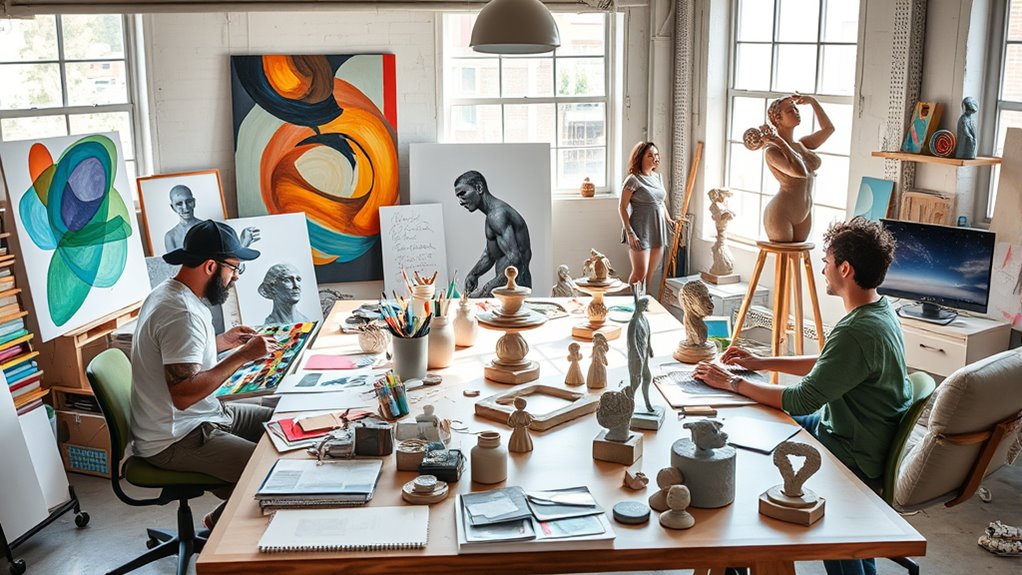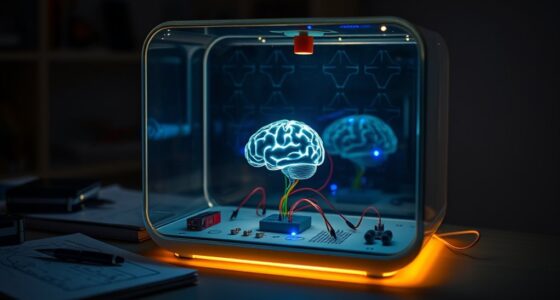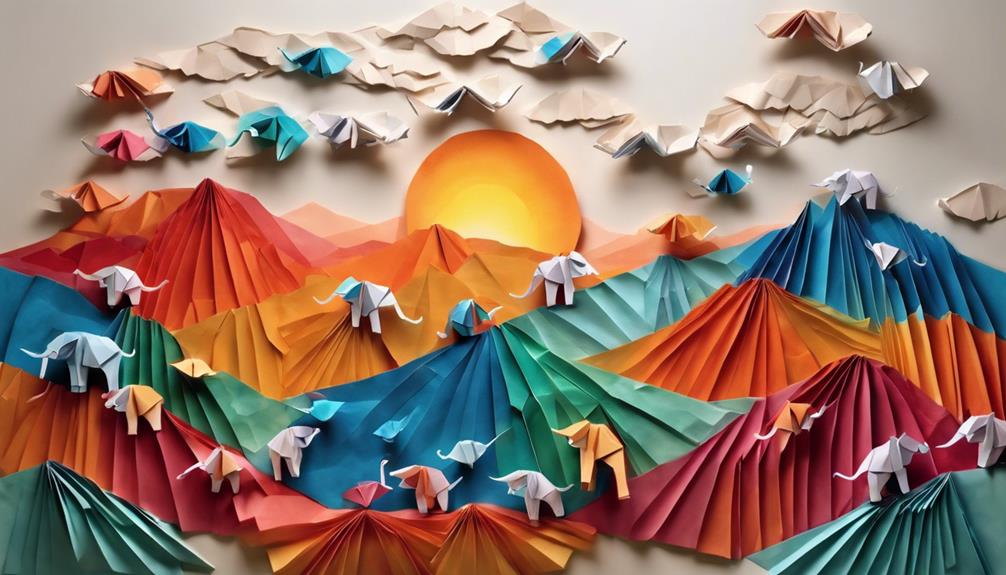Interdisciplinary collaboration in art combines fields like visual arts, technology, dance, and music to spark innovation and push creative boundaries. It lets you experience immersive, interactive projects where audiences get actively involved, breaking away from traditional viewing. By merging diverse expertise, artists create groundbreaking works that challenge perceptions and foster inclusive engagement. This approach reshapes how art is made and experienced, opening new possibilities—discover more about how collaboration fuels artistic innovation.
Key Takeaways
- Facilitates innovative artistic expressions by integrating diverse disciplines like visual arts, technology, dance, and music.
- Enhances audience engagement through immersive, interactive experiences that transform passive viewers into active participants.
- Promotes experimentation with new tools and platforms, pushing the boundaries of traditional art forms.
- Encourages collaboration among technologists, scientists, and artists, fostering fresh perspectives and groundbreaking creations.
- Reshapes artistic creation and experience, making art more inclusive, participatory, and responsive to diverse communities.

Interdisciplinary collaboration in art has become a powerful way to push creative boundaries and forge innovative expressions. When you bring together artists from different fields—visual arts, technology, dance, music, and design—you create a fertile ground for fresh ideas and new ways of seeing the world. This blending of disciplines not only broadens the scope of artistic exploration but also markedly enhances public engagement. By integrating technology into these collaborations, you open up dynamic avenues for audiences to interact with art beyond traditional viewing methods. Technology makes it possible to create immersive experiences, such as virtual reality installations or interactive digital murals, which captivate viewers and invite them to participate actively in the artistic process. Such innovations make art more accessible, encouraging broader public involvement and fostering a deeper emotional connection.
Interdisciplinary art collaboration enhances public engagement through immersive, technology-driven experiences fostering active participation and emotional connection.
You see, when you incorporate technology into interdisciplinary projects, it transforms passive spectators into active participants. For example, an installation might respond to viewers’ movements or voices, making the audience feel like they’re part of the artwork itself. This level of interaction sparks curiosity and invites diverse audiences to engage with art on a personal level. As a result, public engagement doesn’t just increase; it becomes more meaningful. You’ll notice that these collaborations often attract attention from communities and individuals who might not typically visit traditional galleries or attend cultural events. By leveraging technology, you bridge gaps—geographical, cultural, or educational—and create inclusive spaces where everyone can explore and contribute to the artistic dialogue. Additionally, utilizing diverse artistic media enhances the richness and depth of interdisciplinary projects, making them more compelling and multidimensional.
Moreover, integrating technology into interdisciplinary art projects encourages experimentation and innovation. You’re not confined by the limits of conventional mediums; instead, you’re empowered to experiment with new tools and platforms. This flexibility can lead to groundbreaking artworks that challenge perceptions and redefine artistic boundaries. When you combine the expertise of technologists, scientists, musicians, and visual artists, you generate fresh perspectives that push the entire creative landscape forward. In this way, public engagement becomes a two-way street—artists inspire audiences, and audience feedback fuels further innovation. Technology acts as a catalyst, making the entire process more interactive, inclusive, and forward-thinking.
In essence, interdisciplinary collaboration fueled by technology integration reshapes how art is created and experienced. It encourages you to think beyond traditional boundaries, inviting more people to participate in the creative process. The result is a richer, more vibrant artistic environment where public engagement isn’t just a side effect but a core component of the artistic journey. By embracing these collaborations, you help forge a future where art becomes a shared, interactive experience that resonates deeply with diverse communities.
Frequently Asked Questions
How Do Artists Choose Appropriate Collaborators From Different Disciplines?
When choosing partners, you consider their interdisciplinary skills and how well they complement your vision. You look for collaborators whose expertise fills gaps in your knowledge and enhances the project’s depth. You assess their past work, communication style, and willingness to experiment. By choosing partners who bring diverse perspectives, you create a dynamic team that fosters innovation and guarantees a successful, richly layered artistic outcome.
What Are Common Challenges Faced During Interdisciplinary Art Projects?
You might find that cultural differences and communication barriers slow down your project and cause misunderstandings. These challenges make it harder to share ideas clearly and work cohesively. To overcome this, you need open dialogue, patience, and mutual respect. Embracing diverse perspectives can enrich your work, but it’s vital to address these issues early. By fostering clear communication, you guarantee everyone stays aligned and your interdisciplinary art project thrives.
How Does Interdisciplinary Collaboration Influence Audience Perception?
Interdisciplinary collaboration deeply influences your audience’s perception by creating perception shifts that challenge traditional views. As you incorporate diverse perspectives and techniques, your audience becomes more engaged, experiencing heightened emotional and intellectual responses. This dynamic interaction encourages them to see art through multiple lenses, fostering a richer understanding. Ultimately, collaboration enhances audience engagement, making the art more impactful and memorable, and prompting them to question their assumptions and perceptions.
What Funding Options Support Interdisciplinary Art Initiatives?
Imagine your project as a vibrant garden needing fertile ground. You can secure funding through grant opportunities tailored for innovative arts, arts councils, or cultural foundations. Sponsorship strategies, like cultivating allies, help nurture your vision. Seek partnerships with organizations aligned with your interdisciplinary goals. These options act as nourishing rain, helping your initiative bloom into a mesmerizing masterpiece that bridges diverse disciplines and enthralls audiences.
How Can Technology Enhance Interdisciplinary Art Collaborations?
Technology enhances your interdisciplinary art collaborations by providing digital tools and virtual platforms that facilitate seamless communication and idea sharing. You can use these tools to experiment with new mediums, co-create in real-time, and display your work globally. Virtual platforms also allow you to connect with diverse artists, experts, and audiences, enriching your projects with fresh perspectives. Embracing technology makes your collaborative process more innovative, efficient, and accessible.
Conclusion
By blending boundaries and bridging disciplines, you propel art into a powerful, pulsating place of possibility. Collaboration creates connections, cultivates creativity, and crafts compelling concepts that might never emerge alone. When you embrace interdisciplinary efforts, you unearth unique understandings and unearth unexpected innovations. Remember, the magic of art lies in mixing methods and minds — making every moment an opportunity to multiply meaning, multiply mastery, and make your artistic journey truly transformative.










